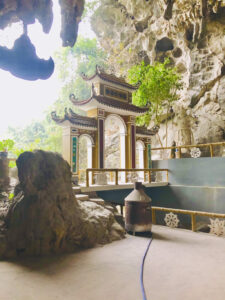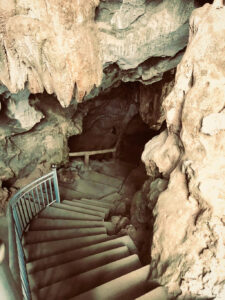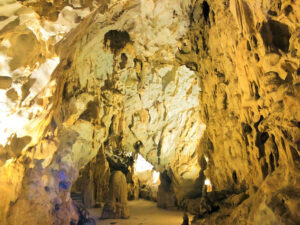The Địch Lộng Pagoda is a superb example of an iconic Vietnamese-Buddhist refuge. Featuring pagodas, an antique Vietnamese communal temple, a meditation garden and both dry and wet caves it is said to be one of the three most beautiful pagodas in North Vietnam. It is also officially recognized as a Vietnamese national historical treasure.
Its form retains the traditional architecture typical of many temples and pagodas in the district. However it is also unique, combining human construction with natural caverns that are imbued with spiritual significance. Such constraints have created a iconic sanctuary that blends society, spirituality, religion and geology together with a stunning location.
According to oral tradition, a woodsman discovered a large cave hidden deep within an isolated forest area while looking for firewood, sometime around 1740. Approaching, the unsuspecting woodsman was awestruck by the sound of wind blowing across the mouth of the cave replicating the sound of a low-pitched flute.
Entering the cavern, he saw it was densely populated with ancient stalagmites/stalactites, further adding to the mystery. Added to the turbulence of low clouds, fog and the wild jungle of this mountainous area, early visitors spoke of the feeling of earthly separation and a nether world of meditation and reflection. Over the years, the fame of this natural wonder spread and locals built a road, constructed the Buddhist pagoda, and added the village communal house to complete the complex.
Background
Zen Master, renowned medical practitioner, and the father of Vietnamese bronze casting, Nguyen Minh Khong led Vietnam’s Buddhist organization during the early Ly Dynasty (1009-1225). During that time, he was instrumental in the construction of some 500 Buddhist temples of which Dich Long is a fine example.
Nguyen Minh Khong is credited with treating the illnesses of both royalty and commoners alike and due to his success, is now revered as both a Saint and a God. After his death in 1141 he has been worshiped as one of the “four immortals” of Vietnamese Buddhism.
In one form or another, Buddhism has been a significant force in the spiritual culture of Vietnamese people. Combined at times with Confucianism, Taoism, and local folk religion, it has formed part of Vietnam’s unique “spiritual architecture”. This is true also at Dich Long, where there are shrines to the Mother Goddess of folk lore, Confucian representations of ancient ancestor worship and of course the more traditional trappings of Buddhism.
Architecture
Modern visitors entering the gated entrance of Địch Lộng Pagoda are greeted by an impressive bell tower carved in stone and wood in the Hoa Lu architectural style. The roof of the bell tower is adorned with sculptures of twisting dragons and lotus blossoms, the Buddhist symbols of purity. However, the focal point of the pagoda’s cultural identity is the old communal temple behind the bell tower.
Skilled artisans from Hoa Lu’s ancient capital created the Địch Lộng community house with a monolithic stone and ironwood structure. The eight massive green stone pillars, each over 4 meters high, are carved with the image of dragons twisting in the sky. Each dragon represents the prosperity of this sacred land that “pulls water up from the earth”.
The left side of the community house has a garden of Buddhist sculptures, with statues of Amida, Maitreya, Arhat, and the infant Buddha Shakyamuni. There is also a tiny lake with a bridge that leads to Guanyin’s statue, surrounded by flowers, grass, and ancient trees. The statuary and gardens cover a large area and are very photogenic but are largely uncovered so a hat and water are recommended.
Behind the community house, the Ha (lower) pagoda follows traditional Ninh Binh strictures, with the three sections built against the living mountain. Inside, there are shrines to Buddha and the immortal gods of Vietnam while on the opposite side there is a semicircular lake that balances earth, air, and water. The dragons carved into each corner of the pagoda’s roof reach up against the blue sky, while doves perch on the pagoda’s roof, blending with the green of the mountains and woodlands to radiate peace and serenity.
Địch Lộng Cave
Visitors to Địch Lộng Pagoda need to climb the 105 stone steps located behind the Ha pagoda to reach the cave itself, considered one of the highlights of the Pagoda. The cave comprises two connecting caverns, the Light cave and the Dark cave, as guests enter through the “Triple Gates” of Vietnamese Buddhism.
Inside the cave, visitors are greeted with an 8-meter high dome adorned with sculptures of the Dharma Protector on both sides. Above the dome hangs a 1-ton bell cast during the Nguyen Dynasty. There is a shrine to the Mother Forest Goddess of Vietnamese folk religion at the front of the cave, while the altar on the right is surrounded by Buddha statues of varying sizes.
To enhance the experience, the Pagoda trustees have established a light system and created a path for tourists to traverse the length of the cave. Such constructions take away some of the mystery of the place but allow a full (and safer!) appreciation of this natural wonder. Progressing through the cave, the stalactites spark the imagination. It is said they describe the six realms of rebirth and existence recreated in natural “stalactite paintings” and displaying ancient Buddhist cosmology.
Starting from the dome area, visitors will see twinkling electric lights depicting the realms of the gods (deva), demi-gods (asura), people (manua), animals (tiryak), hungry ghosts (preta), and hell realm (naraka), revealing various scenes from Buddhism, including images of gods celebrating and immortal spirits of the ‘demi-gods’ dancing in the clouds.
Rock Music
For much of its known existence, the cave at Địch Lộng was viewed in the flickering light of candles and lanterns and the abundance of stunning stalactites have a unique property. If struck lightly with a stone, these geological formations produce a drum-like sound in tune with the flute-like melodies created by the wind blowing across the mouth of the cave.
The water drops from the porous limestone grotto tinkle and splash to add to this natural symphony, creating a soothing subterranean music. The constant drips also contribute to the cave’s small rock pool referred to as the “magic well” by locals. It is believed that drinking this water can heal all ailments and shed doubt and turmoil from a person’s heart.
After the mystical experience of the light and dark caverns, visitors continue on to the back of the cave to witness the natural landscape of the mountains and sky in all its glory. The journey through the Ha pagoda and the caves is regarded in local belief as a physical metaphor for rebirth within the cycle of existence and the path of Enlightenment that leads to Nirvana.
According to Buddhist teachings, human emotions are in constant flux and to alleviate the “suffering of samsara” is is a necessity to adjust one’s temperament and emotions. It is believed that Địch Lộng’s natural wonders are a gift from Buddha’s pantheon to bestow this message to each person who takes the time to visit.
Travel Tips
When visiting the village pagoda area, visitors should be appropriately dressed and carry any necessities. Visits are free of charge as is parking, although during holiday periods it becomes crowded. Remember, it is advised to properly secure your vehicle and valuables as not all visits are of a spiritual nature.
While not mandatory, a small donation will not only show appreciation but also contribute to the maintenance of the pagoda.
Similar to most pagodas in Vietnam, the first day of the Lunar New Year is a busy time to visit while the Pagoda specific annual Địch Lộng Festival takes place on the 6th and 7th of the third lunar month.
In the monsoon season or after heavy rain, the cave system may be temporarily closed due to flooding. This is for safety reasons, due to the slippery paths and the installed electrical system. Follow the directions of the monks and plan your visit accordingly
Coming from Ninh Binh, Dich Long Pagoda is located along a less-traveled road but is still easily accessible from the arterial road linking Hanoi to the district capital 90 km away. If you’re on a day tour from Hanoi to Ninh Binh, it should be easy to negotiate a brief stop at Dich Long if it’s not already included in the schedule.
Self-driving or traveling with a tour group may be your best options if staying in Ninh Binh. If you hire a taxi or a Grab ride, make sure to arrange for them to wait, as finding a return ride could be difficult. Dich Long Pagoda is truly a magnificent example of Vietnamese spiritual architecture and well worth the effort.
Note
The neglect of Địch Lộng Pagoda in recent years may be due in large part to the impact of a nearby cement factory. Many trucks carrying loads of limestone and gypsum constantly bypass the arterial road, creating a layer of fine white dust over much of the exterior of the temple area (the interior and the caves themselves are unaffected). Enforcing proper loading and covering of the trucks is a simple solution that could be implemented, and the economics of tourism could potentially encourage local businesses to adopt a more ecological attitude.






